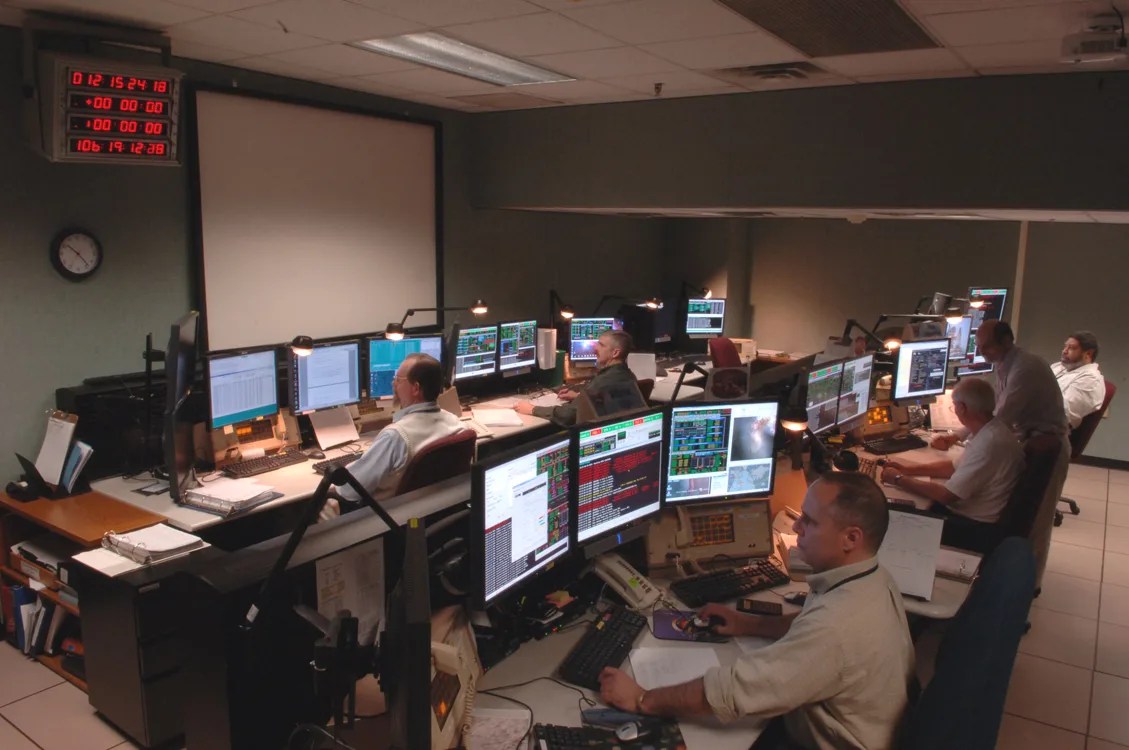5 min read
The Hubble Space Telescope has logged millions of miles and taken thousands of pictures since its launch in 1990, thanks in part to the around-the-clock efforts of a small group of dedicated engineers and technicians at NASA's Goddard Space Flight Center in Greenbelt, Md.
"Hubble is a truly amazing telescope, but as sophisticated as it is, it can't function completely on its own," says Hubble Operations Manager Mike Prior at Goddard. "That's why technicians provide around-the-clock support in the Mission Operations Room command center."
It's up to mission operations staff to upload the commands to Hubble that tell it where to point and when, what sensing instruments to use, and when to send data back to Earth. They also troubleshoot any problems that may arise.
According to Prior, there are always at least four flight controllers on duty in the Space Telescope Operations Control Center, managing Hubble's daily operations. During each shift, the flight controllers receive support from at least two data operations technicians.
"From the ground, we monitor the health and status of the telescope all the time," Prior says. "Without all the operators here, Hubble would be unable to perform science observations because it wouldn't know where to point, and wouldn't be able to send the data back to the ground to the thousands of scientists around the world."
To help the staff stay on top of telescope operations, Hubble transmits engineering data back to the command center at Goddard. That data contains information on how the telescope is functioning.
Training and Staffing Up for Servicing Mission 4
With the fifth Hubble servicing mission scheduled for 2009, the command center's responsibilities will swell far beyond normal day-to-day operations. Shortly before the upcoming servicing mission, about 50 engineers will begin working full-time in the Servicing Mission Operations Room. The team will work in 12-hour shifts supporting mission preparations, test and simulations. During the mission they are responsible for commanding (that is, controlling) Hubble.
These extra hands on deck are vital for mission success because of how much more complex operations become during a Hubble servicing mission. "You're putting the telescope into modes it's not normally in, and turning things off and back on," says Prior. "There's a lot more complexity involved when you do that."
Think of normal Hubble operations as cooking dinner for a family of four. The servicing mission would be like preparing a banquet for a 100-person wedding party. The coordination effort becomes much more intense.

Practice Makes Perfect
Detailed preparation and training for a Hubble mission begin years before launch. Considering Hubble has only been serviced four times since it launched in April 1990, and the last visit to the telescope was in 2002, the STOCC team truly benefits from refresher training. Many of the engineers have worked previous servicing missions, but for a handful this Hubble mission will be their first.
To help the STOCC team prepare for the servicing mission, training simulations, or "sims" as the team calls them, are conducted in the STOCC.
To duplicate the real thing, engineers use a sophisticated software program carefully designed to exactly duplicate Hubble's behavior. Mechanical simulators would require modifications to mimic problems, but this software allows operators greater freedom to "play with parameters and make things look like they're not going according to plan without actually doing anything to Hubble," Prior says.
Throwing Curve Balls
Each simulation is more intense than what is expected during the actual mission. The managers keep secret the emergency scenarios they throw out to the team, which keeps operators on their toes. Types of simulated faults run the gamut and may include difficulty powering Hubble back up after an instrument installation, problems closing the telescope's aperture door, or communications errors. These little hiccups better prepare the team for potential real issues with Hubble during the mission.
Controllers began conducting sims in August 2007. Twelve sims are scheduled to occur before Atlantis lifts off this summer. Each person scheduled to staff the STOCC command center during the Hubble mission must successfully complete a minimum of 35 hours of training.
The shortest STOCC sim is seven hours, with the longest topping out at 39, and the average ones are anywhere from 12 to 14 hours. Goddard also typically conducts eight joint sims with NASA's Johnson Space Flight Center. They can last from nine to 36 hours.
"The Goddard sims and joint integrated sims with NASA's Johnson Space Center more than satisfy the training requirement," says Pete Pataro, a Hubble Operations Support Team member at Goddard. Pataro has participated in every servicing mission since Hubble's first in 1993.
Many Tasks, Only Five Space Walks
The seven astronauts selected for the last service call to the famed telescope have many tasks to accomplish, and they only have five spacewalks in which to complete them. Each spacewalk is only about six hours long.
"Hubble Servicing Mission timelines have always been totally subscribed, and this mission is no different," says Mike Weiss, Hubble's Technical Deputy Program Manager at Goddard. The SM4 astronauts will be called upon to install two new science instruments, repair two existing ones, install a Fine Guidance Sensor, replace the gyroscopes and batteries, and perform other activities so efficiency is of the utmost importance both in orbit and on the ground.
With the exceptional experience and dedication of the STOCC team, Hubble team and the astronauts, this servicing mission will extend the operational life of the telescope for at least five years - possibly offering overlapping observations with a follow-on mission: the James Webb Space Telescope.
Related link:
By Robert Garner
NASA's Goddard Space Flight Center, Greenbelt, Md.








